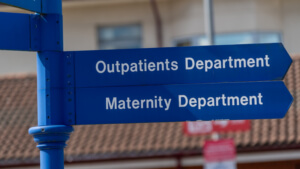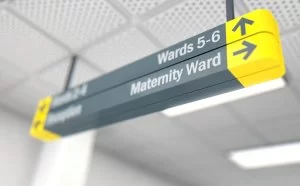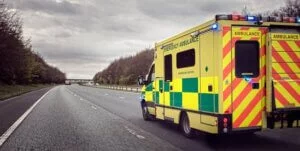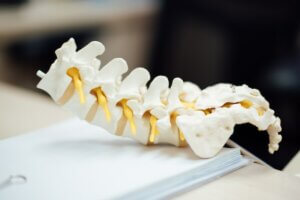Missed fracture compensation claims
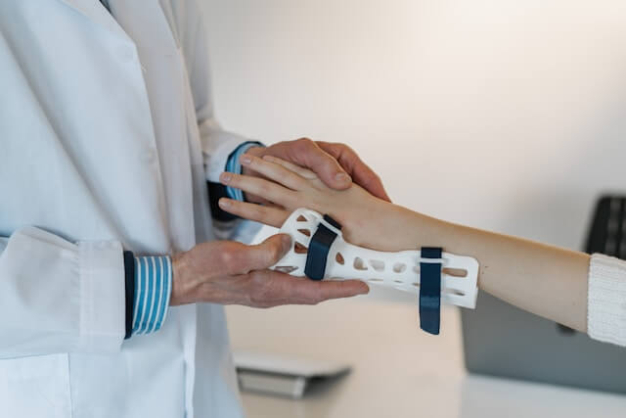
Contact
Table of Contents
Missed fractures and orthopaedic negligence
What is a bone fracture?
A bone fracture occurs when the structure is damaged, causing the bone to break into 2 or more pieces. A fracture can occur for several reasons:
- High-impact trauma, such as a car accident.
- Medium impact trauma such as a fall. However, healthy bones should withstand a fall from a standing height. So, a hip fracture following a slip or trip is a red flag that could signal the presence of a medical condition such as osteoporosis or bone cancer. Elderly people are at greater risk of fractures from slips and trips because of a pre-existing medical condition.
- Low or no impact, but when the bone is weakened due to a medical condition. These types of fractures are known as pathological fractures.
Older adults are particularly vulnerable, as conditions like osteoporosis increase the risk of fractures from minor slips or trips.
How common are fractures?
Fractures present a considerable public health burden, with around 3.6 fractures per 100 people per year in England alone. Each year 1 in every 100 people will suffer a bone fracture. At the same time, around 10 million of the 20 million trips to Accident and Emergency annually result in an X-Ray examination to rule out or diagnose a break.
The personal burden of fracture is also high; complications from an undiagnosed fracture include short-term problems such as damage to muscles, blood vessels and joints, medium-term problems such as infection and clot formation and longer-term conditions such as stiffness and arthritis. Fractures can also adversely affect long-term quality of life due to loss of function and independence. Confidence can also suffer.
Winter sees a spike in fractures
According to the Royal Osteoporosis Society, winter is a time of fractures. The National Hip Fracture Database indicates an 8% increase in hip fractures during the winter months compared to the rest of the year. Ankle fractures and foot fractures occur more frequently in winter too. Wrist fractures due to falls are also more likely in colder weather.
Unfortunately, failure to detect a fracture on an X-ray is one of the most common errors in Accident and Emergency Departments. Here are some real-life cases of missed fractures.
Any bone in the body is vulnerable
A missed skull fracture can lead to permanent brain damage or death. An incorrect diagnosis of a wrist fracture can result in the delayed or incorrect union of the bones, resulting in impaired hand function. This year, doctors failed to diagnose a hip fracture in a man complaining of back and leg pain, despite spending 4 days in a hospital orthopaedic ward.
What happens if your hospital misses a fracture?
If fractures are identified correctly and managed properly, there is a greater chance that healing will be complete, and the bone will return to normal functioning. In contrast, if a fracture is not identified and treated, patients may suffer:
- prolonged pain and swelling
- infection or blood clots
- permanent joint stiffness or deformity
- long-term mobility issues
Some fractures, such as hairline fractures, or fractures in bones that are difficult to visualise, such as the scaphoid bone in the wrist are commonly missed.
Real-life examples of missed fractures
- A 37-year-old woman suffered a spinal fracture during childbirth. Her bones were weakened due to a medical condition called osteopenia. However, the fracture and her bone weakness were only diagnosed after she suffered 6 months of severe pain, and she finally received a diagnostic MRI scan.
- And just this month it was reported that a footballer continued to play for 6 weeks after sustaining a fractured leg. He had received two X-rays at the time of his injury, but the fracture was missed. A third X-ray finally showed up his broken leg bone.
- A contestant in the Miss World contest was found to have a missed wrist fracture, initially diagnosed as a sprain. A junior doctor and fellow contestant recognised the injury and requested a new X-ray.
Can I claim compensation for a missed fracture?
Yes, if a fracture was missed or wrongly diagnosed due to medical negligence, and you suffered avoidable harm as a result you may be entitled to compensation.
To bring a claim, we’ll need to show that:
- A healthcare professional failed to meet acceptable standards of care
- That failure led to a delay in diagnosis or treatment
- You suffered harm as a direct result
We have successfully acted for clients in missed fracture claims, including:
A woman who fractured her hip after a fall at home. Despite multiple GP and A&E visits and ongoing pain, the fracture was not diagnosed for seven weeks. She was later awarded compensation for the avoidable harm she endured.
Speak to an expert
To speak with one of our medical negligence solicitors, contact us by:
- Filling in our online enquiry form; or
- Calling us on 020 7485 8811
Share this article
“Small but very effective and experienced team so every client benefits from the personal touch but also highly skilled litigation know-how. Capability of the team means they can handle all aspects of very complex cases as well as straightforward matters.”
“Osbornes Law is an established firm which handles a breadth of complex and high-value clinical negligence matters.”
Contact us today
Call us 020 7485 8811
Email us Send us an email and we’ll get back to you
Osbornes has a skilled team of solicitors advising clients on a wide range of clinical negligence matters.
Hard working, approachable, good knowledge of clinical negligence and clients’ specific conditions
A joy to work with and always 100% client focused at all times.
The clinical negligence team at Osbornes is much lauded for its ability to ‘represent the diverse range of London-based clients
Stephanie has developed a particularly strong reputation for her handling of birth injury claims, as well as cases concerning surgical negligence and delays in surgery.
"An excellent firm which achieves fantastic outcomes for clients."
"Stephanie Prior takes on complex cases and gets excellent results. She has a background in medicine which serves her clients well and is a realistic but tough litigator."
"Stephanie Prior is hugely dedicated, adored by her clients, tenacious, efficient and extremely knowledgeable."
"Stephanie Prior is very good with troubled clients and is easily able to make them feel at ease."
"Stephanie shows sensitivity and deals with things in an understanding way."
Osbornes provides a very intimate and personal client service which is increasingly rare in this sector.
The lawyers in the team are highly experienced and will drive cases very hard on behalf of their clients.
"Stephanie Prior has a realistic attitude to the complexities of the cases. She wins the trust of her clients and goes the extra mile to ensure they get the best outcomes."
"Stephanie Prior... manages a varied caseload, including obstetric claims, child and adult brain injury cases and fatal and non-fatal spinal cord injury cases."
"Stephanie is experienced, knowledgeable of all aspects of clinical negligence work, and strategic in running cases."
"The team were extremely professional in putting my needs first. There was a joined-up approach to catering for the client, and all lawyers involved were briefed and constructive."
Stephanie Prior is always very professional and kind. Highly recommended.
Quite simply excellent, with a highly competent and well-rounded team. They understand complex medical litigation and have been our lifesavers, and we will always owe them our immense gratitude.
More from JodiVIEW ALL
- 10.7.2025
Osbornes Law Secures £700K in Crohn’s Negligence...
Negligent delay in diagnosing Crohn’s disease leads to £700K settlement Jodi Newton, Partner, was instructed in a case against...
Read more - 12.5.2025
Complaints Against Suspended Surgeon Ms Kuldeep Stohr
Ms Kuldeep Stohr, orthopaedic surgeon at Addenbrooke’s Hospital suspended In February 2025, Cambridge University Hospitals NHS Foundation Trust (CUH) confirmed...
Read more - 6.5.2025
Six-Figure Settlement for Negligent C-Section Delivery
Osbornes secures a six-figure settlement following a negligent caesarean section delivery Jodi Newton, Partner and head of our Obstetric and...
Read more - 13.3.2025
Addenbrooke’s Hospital Complaints
Review finds harm to children by surgeon at Addenbrooke’s Hospital An independent review by Cambridge University Hospitals NHS Foundation...
Read more - 14.10.2024
Multi-Million Settlement in Cerebral Palsy Negligence Case
Judge awards multi-million settlement in cerebral palsy medical negligence claim Jodi Newton, Partner and specialist medical negligence lawyer at Osbornes...
Read more - 12.9.2024
Great Ormond Street Hospital Negligence & How to Claim
Review of negligence at Great Ormond Street Hospital At Osbornes Law, we’ve supported families through some of the most...
Read more - 29.8.2024
AB v Central London Community Healthcare NHS Trust
Background Our client, AB, had been using the Nexplanon contraceptive device for 6 years. She had a Nexplanon device inserted into...
Read more - 30.7.2024
What Is the Role Of a Physician Associate?
What does the Position of Physician Associate Mean for the NHS? There are many different jobs within the NHS, each...
Read more - 9.5.2024
Claim Against Royal Free London NHS Foundation Trust...
Client obtains settlement after being victim of a surgical negligence Jodi Newton, Partner in our Clinical Negligence department, recently settled...
Read more - 11.1.2024
New UK Supreme Court Ruling regarding Secondary Victims...
The Supreme Court has today, on the 11th January 2024, upheld the Court of Appeal’s order to dismiss the claims...
Read more - 11.1.2024
Secondary Victim Claims
Secondary victims in clinical negligence cases What is a secondary victim in clinical negligence cases? Most compensation claims are concerned...
Read more - 12.12.2023
NHS Compensation Payouts Guide
What Are NHS Compensation Payouts? In the UK, the National Health Service delivers the vast majority of healthcare services. When...
Read more - 21.9.2023
Large Compensation for Delayed Laryngeal Cancer Diagnosis
Actress receives financial award after life-changing missed cancer diagnosis. Jodi Newton acted for a client who was belatedly diagnosed with...
Read more - 21.9.2023
Delayed cervical cancer diagnosis client story
Introduction Jodi Newton acted for a woman who died following a delayed cervical cancer diagnosis. The deceased could have been...
Read more - 19.9.2023
Appendicitis Compensation Claim
Appendicitis misdiagnosis case settles for 5-figure sum Osbornes Law were instructed in a medical negligence claim against Bedfordshire Hospitals NHS...
Read more - 19.9.2023
Spinal Fracture Case Settles for 6-figure Sum
Spinal Fractures following cessation of Denosumab injection Case Overview Stephanie Prior was instructed in a spinal injury claim against Mid...
Read more - 31.8.2023
Can you sue the NHS for waiting times?
The NHS is facing an unprecedented challenge with 7.47 million people waiting for routine treatments. This crisis impacts everyone, from those...
Read more - 31.8.2023
Hyponatraemia – Symptoms, Causes & Negligence
What is hyponatraemia? Hyponatraemia is a condition where sodium levels fall below a certain level, which can be dangerous. All...
Read more - 10.8.2023
Ambulance Delays Affecting Rapid Patient Treatment
Failure to Meet Ambulance Response Targets In 2017, the Secretary of State for Health accepted the new ambulance performance standards recommended...
Read more - 1.8.2023
Bowel Ischaemia Fatality – Client Story
Jodi Newton, a Partner in the Clinical Negligence Department at Osbornes Law, has recently settled a long running fatal medical...
Read more - 26.7.2023
Private Healthcare Negligence
Can you claim medical negligence against a private hospital? Yes – it can be a little more complicated than bringing a...
Read more - 9.6.2023
Early Notification Scheme – is it helping or failing...
What is the Early Notification Scheme? The NHS Early Notification Scheme (“ENS”) has reached its sixth anniversary. Established in April 2017,...
Read more - 23.3.2023
Private Pregnancy Scans and Substandard Care
In the news, it has been reported that private clinics that offer pregnancy scans to women are not meeting the...
Read more - 9.2.2023
Perineal tear claim settles for 6-figure sum
Successful claim for mother with third-degree perineal tear Osbornes Law recently settled a birth injury claim for a woman who...
Read more











